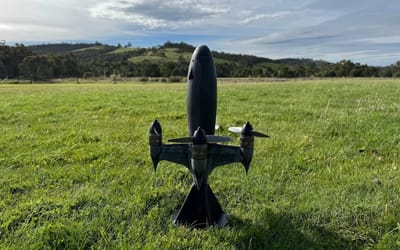Avatar 3 will have an anti-AI disclaimer - here's what that means for the movie's breathtaking special effects
Published on Aug 01, 2025 at 7:38 PM (UTC+4)
by Ben Thompson
Last updated on Aug 01, 2025 at 8:50 PM (UTC+4)
Edited by
Ben Thompson
Avatar 3: Fire and Ash is reportedly going to contain an anti-AI disclaimer, making it known that its special effects are the work of human beings.
The first trailer for the long-awaited sequel has dropped, and people are understandably blown away by its effects.
The world of Pandora has never looked so vivid and mesmerizing before.
But reports have circulated that the movie will contain an anti-AI disclaimer, which raises the question: how are these stunning effects done?
EXPLORE SBX CARS – Supercar auctions starting soon powered by Supercar Blondie
The anti-AI disclaimer reportedly being featured in Avatar 3
When the first Avatar movie came out in 2009, it blew audiences away with its reality-defying special effects.
The blue Na’vis and the moon of Pandora enchanted moviegoers around the world and netted nearly $3 billion at the box office.
It’s no wonder that Matt Damon was kicking himself for turning down the lead role.

The sequel, The Way of Water, followed thirteen years later and grossed more than $2 billion.
Now, the third installment, Avatar 3: Fire and Ash, is on its way – and the epic trailer gave us a lot to be excited for.
Fire and Ash is expected to pick up where the last movie left out, and doesn’t disappoint on the visual front.
Pandora looks as enchanting – and dangerous – as before.
But one thing’s for certain – this entire world is the work of a very talented special effects team, not AI.
And James Cameron, the movie’s director, reportedly wants you to know that.

Back in February, it was widely reported that an anti-AI title card would open up the movie.
Cameron reportedly said this during a Q&A session in New Zealand, in attendance by X user Josh Harding.
Sharing a picture of the critically acclaimed director to X, Harding shared some details on what had been said.
“Such an *incredible* talk. Also, James Cameron revealed that Avatar: Fire and Ash will begin with a title card after the 20th Century and Lightstorm logos that ‘no generative A.I. was used in the making of this movie’,” he wrote.
However, it’d be a mistake to say he’s anti-AI on the whole – he actually has quite nuanced views on the subject.
“I don’t believe [AI is] ever going to have something that’s going to move an audience. You have to be human to write that. I don’t know anyone that’s even thinking about having AI write a screenplay,” he told CTV News in 2023.
However, he seemed a little more open to AI during an April 2025 appearance on the Boz to the Future podcast.
Having joined the board of directors for Stability AI back in September 2024, it’s fair to say that he’s not shut off to the technology altogether.

On the podcast, he said that if filmmakers wanted to continue to see movies like Dune, or indeed one of his own movies, there needs to be a way to cut special effects budgets in half.
And that’s not even going into the money it took to keep Timothée Chalamet cool in the desert heat.
He emphasized that using AI wasn’t ‘about laying off half the staff at the effects company’.
“That’s about doubling their speed to completion on a given shot, so your cadence is faster and your throughput cycle is faster, and artists get to move on and do other cool things and then other cool things, right?” he said.
“That’s my sort of vision for that.”
How James Cameron and his team created Pandora
Whether or not Cameron will start implementing AI after Avatar 3 drops remains to be seen.
But for now, let’s reflect on the hard work that goes into creating the special effects for the movies as they are now.
Wētā FX is the New Zealand special effects team that’s working on the Avatar sequels.

You may also recognize their work from the Lord of the Rings trilogy.
Given that the second movie only contained two shots with no VFX, we can expect similar things in the third outing.
A number of technological improvements occurred between the first and second movie.
Lightweight HD head cameras were used to record the actors’ facial performances.
This allowed for actors like Sam Worthington and Sigourney Weaver to truly embody their blue-skinned characters.
There were also two digital puppets to work with in the second movie, as opposed to just one.

One was an accurate copy of the real-life actor, whilst the other was of the actor’s character.
This allowed the special effects team to make the character’s movements match the actor’s as closely as possible.
The second movie featured extensive amounts of underwater scenes, which proved to be a challenge for the motion capture system.
“It’s never been done before, and it’s very tricky because our motion capture system, like most motion capture systems, is what they call optical base, meaning that it uses markers that are photographed with hundreds of cameras,” Cameron told Collider.
“The problem with water is not the underwater part, but the interface between the air and the water, which forms a moving mirror.
“That moving mirror reflects all the dots and markers, and it creates a bunch of false markers. It’s a little bit like a fighter plane dumping a bunch of chaff to confuse the radar system of a missile.

“It creates thousands of false targets, so we’ve had to figure out how to get around that problem, which we did.”
That’s tech speak for ‘water makes things ten times harder for the special effects team’.
Avatar 3 is set to have underwater scenes too, but other details of the movie have been kept relatively quiet.
Either way, we know we’re in for another few hours of cinematic spectacle.
See the trailer for Avatar 3: Fire and Ash in full here.
DISCOVER SBX CARS: The global premium car auction platform powered by Supercar Blondie




